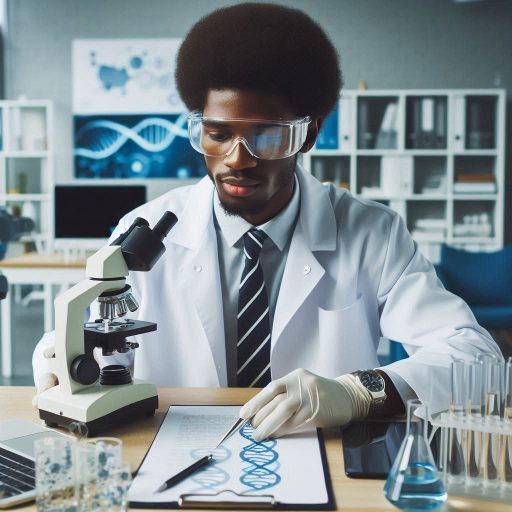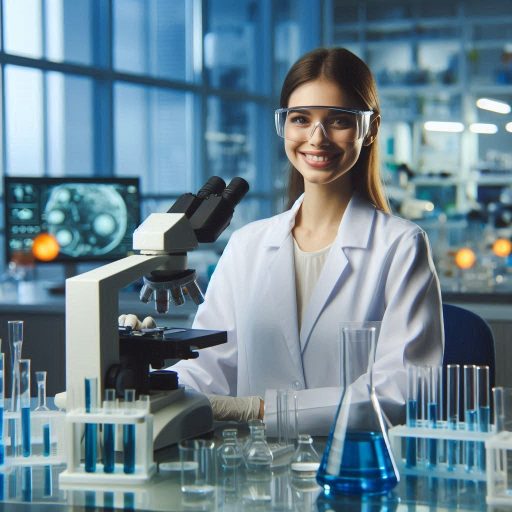Introduction
Biomedical engineering lab techniques are essential for conducting research and developing innovative healthcare technologies.
These techniques involve working with biological samples, designing medical devices, and testing materials for medical applications.
Engineers use various methods such as imaging, tissue engineering, and biomechanics analysis to advance medical solutions.
Following best practices in a lab setting is critical for ensuring accurate results and maintaining safety.
Proper lab protocols help prevent contamination and errors that could compromise the research.
Ensuring equipment is calibrated correctly and handled with care is essential for producing reliable data.
Lab safety is crucial for protecting researchers from hazards like chemicals, bioagents, or electrical equipment.
Wearing protective gear, following waste disposal guidelines, and maintaining a clean workspace minimize risks in the lab.
Adhering to ethical guidelines is equally important in biomedical engineering labs.
Researchers must ensure their experiments are conducted responsibly, particularly when handling human or animal samples.
Documenting every step of the process ensures transparency and allows others to replicate the study.
Mastering lab techniques and following best practices in biomedical engineering is vital.
It ensures the success of research, the safety of the lab, and contributes to advancements in healthcare technology.
Understanding Biomedical Engineering Lab Techniques
Defining Biomedical Engineering Lab Techniques
Biomedical engineering lab techniques encompass various methods and procedures used in research and development.
These techniques help engineers and scientists study biological systems and develop medical technologies.
A solid understanding of these techniques is essential for success in the field.
Biomedical engineering combines principles from engineering and biological sciences.
This integration allows researchers to explore complex biological processes and develop innovative solutions.
By mastering lab techniques, professionals can effectively contribute to advancements in healthcare.
Types of Biomedical Engineering Lab Techniques
Cell Culture Techniques
Cell culture techniques are fundamental in biomedical engineering.
Researchers grow cells in controlled environments to study their behavior and interactions.
This method allows scientists to analyze cellular responses to drugs and environmental changes.
Using cell culture, researchers can develop and test new pharmaceuticals.
This technique is crucial for drug discovery and toxicity testing.
Additionally, cell cultures help in tissue engineering applications, providing a platform for creating artificial tissues.
Microscopy Techniques
Microscopy techniques play a vital role in visualizing biological samples.
Different types of microscopy, such as light microscopy and electron microscopy, allow for detailed observation.
Light microscopy enables researchers to see live cells and tissues, while electron microscopy provides high-resolution images of cellular structures.
Microscopy techniques help scientists study cellular morphology and organization.
By examining samples under a microscope, researchers can gain insights into cellular functions and disease mechanisms.
These observations are crucial for understanding how diseases progress and how to develop targeted therapies.
Molecular Biology Techniques
Molecular biology techniques are essential for studying the molecular mechanisms of life.
Techniques such as PCR (polymerase chain reaction) and gel electrophoresis allow researchers to analyze DNA and RNA.
PCR amplifies specific DNA sequences, enabling detailed genetic analysis.
Gel electrophoresis separates DNA fragments based on size, helping visualize genetic material.
These techniques are vital for genetic engineering, diagnostics, and understanding gene expression.
Researchers use molecular biology techniques to investigate the roles of specific genes in health and disease.
Biochemical assays are methods for analyzing biological samples to understand their composition and activity.
Techniques like enzyme-linked immunosorbent assay (ELISA) detect specific proteins in a sample.
Researchers often use ELISA in diagnostics and research to quantify proteins of interest.
Other assays, such as Western blotting, allow scientists to detect specific proteins within complex mixtures.
These biochemical techniques are essential for drug development and understanding disease mechanisms.
Best Practices in Biomedical Engineering Labs
To ensure safety and accuracy, researchers must adhere to best practices in the lab.
Always follow standard operating procedures (SOPs) for each technique.
Proper training and supervision are essential, especially for complex procedures.
Maintaining a clean and organized workspace helps prevent contamination.
Regularly calibrate equipment to ensure accurate measurements.
Documenting all experiments thoroughly provides valuable data for future reference.
Mastering biomedical engineering lab techniques is crucial for researchers and engineers in the field.
Techniques such as cell culture, microscopy, and molecular biology enable significant advancements in healthcare.
By adhering to best practices, professionals can ensure the reliability and safety of their research, ultimately contributing to better medical technologies and treatments.
Read: U.S. Cities with the Most Opportunities for Environmental Scientists
Importance of Best Practices in Biomedical Engineering Labs
The Significance of Following Best Practices in a Lab Setting
Following best practices in a biomedical engineering lab is crucial for safety and success.
These practices ensure reliable and reproducible results.
When researchers adhere to established protocols, they minimize variability and enhance the integrity of their data.
Best practices also promote a safe working environment.
Laboratories often contain hazardous materials and complex equipment.
Adhering to safety protocols protects researchers and prevents accidents.
Proper training and regular safety drills contribute to a culture of safety within the lab.
Following best practices fosters effective communication among team members.
Clear documentation of procedures and results allows for seamless collaboration.
When everyone follows the same standards, it reduces misunderstandings and errors during experiments.
Moreover, regulatory compliance is essential in biomedical engineering.
Laboratories must adhere to guidelines set by organizations such as the Food and Drug Administration (FDA) and the Occupational Safety and Health Administration (OSHA).
Compliance not only safeguards researchers but also ensures the ethical conduct of experiments.
Potential Risks and Consequences of Not Adhering to Best Practices
Failing to follow best practices can lead to significant risks and consequences.
One major risk is the possibility of accidents or injuries.
Working with chemicals, biological agents, or complex machinery without proper protocols can result in spills, burns, or exposure to harmful substances.
Not adhering to best practices can compromise experimental results.
Inaccurate measurements or poorly executed procedures can lead to invalid data.
Researchers may misinterpret their findings, potentially resulting in misguided conclusions.
The financial implications of neglecting best practices can be severe.
Poorly designed experiments can waste valuable resources, such as time and materials.
Repeating experiments due to errors incurs additional costs, delaying research progress.
Furthermore, failure to follow regulatory requirements can lead to legal consequences.
Laboratories that do not comply with safety standards may face fines or penalties.
In extreme cases, researchers could lose their licenses or face criminal charges for negligence.
Non-compliance can also harm a research institution’s reputation.
Universities and organizations rely on their credibility to attract funding and collaborations.
Incidents resulting from neglecting best practices can tarnish their standing in the scientific community.
Adhering to best practices in biomedical engineering labs is essential for ensuring safety, reliability, and compliance.
Following established protocols not only protects researchers but also enhances the quality of experimental outcomes.
Conversely, neglecting these practices can lead to serious risks, including accidents, compromised data, financial losses, and reputational damage.
To foster a productive and safe laboratory environment, researchers must prioritize best practices.
By promoting safety culture and effective communication, laboratories can achieve their research goals while protecting their personnel and the integrity of their work.
Embracing these principles is vital for advancing the field of biomedical engineering and ensuring successful outcomes.
Read: Environmental Scientist vs. Ecologist: Roles and Differences in the US
Safety Protocols in Biomedical Engineering Labs
Essential Safety Protocols in Biomedical Engineering Labs
Safety is paramount in biomedical engineering labs.
Following essential safety protocols protects both personnel and the integrity of research.
Start by familiarizing yourself with the lab’s safety manual.
This document outlines procedures and emergency contacts specific to your laboratory.
Ensure that all equipment is in good working order before use.
Regularly check for any signs of wear or malfunction.
Report any issues immediately to maintain a safe working environment.
Always maintain a clean workspace, as clutter can lead to accidents.
Proper waste disposal is crucial in biomedical labs.
Identify and segregate hazardous materials according to the guidelines.
Use designated containers for biohazardous, chemical, and sharps waste.
Proper disposal helps prevent contamination and protects the environment.
Know the location of safety equipment, such as fire extinguishers and first aid kits.
Familiarize yourself with emergency exits and evacuation procedures.
Regular safety drills can prepare you for emergencies and enhance your response skills.
Importance of Personal Protective Equipment (PPE)
Wearing appropriate personal protective equipment (PPE) is vital in a biomedical engineering lab.
PPE minimizes exposure to hazardous materials and protects against potential injuries.
Common PPE includes lab coats, gloves, goggles, and face shields.
Lab coats provide a barrier against spills and splashes.
They also protect personal clothing from contamination.
Choose lab coats made of durable, chemical-resistant materials for optimal safety.
Ensure that your lab coat fits properly and covers your arms.
Gloves serve as the first line of defense against chemicals and biological agents.
Always select the right type of gloves for the materials you are handling.
Latex, nitrile, and vinyl gloves each offer different levels of protection.
Goggles or safety glasses protect your eyes from splashes and airborne particles.
Ensure that your eyewear fits properly and meets safety standards.
In some cases, a face shield may be necessary for additional protection.
Wearing appropriate PPE is not just about individual safety; it sets a standard for the lab environment.
Encouraging a culture of safety promotes responsible behavior among all lab personnel.
When everyone adheres to PPE protocols, the overall safety of the lab improves.
Training and Compliance
Regular training sessions on safety protocols and PPE usage are essential.
Participate in workshops to enhance your understanding of best practices.
These sessions also reinforce the importance of adhering to safety measures.
Compliance with safety protocols and PPE requirements is not optional.
Non-compliance can lead to accidents and jeopardize research integrity.
Laboratories must establish clear consequences for failing to follow safety measures.
Adhering to essential safety protocols is crucial in biomedical engineering labs.
Following these protocols protects personnel and ensures a productive research environment.
Wearing appropriate personal protective equipment is vital for minimizing risks and injuries.
By prioritizing safety and compliance, researchers can foster a culture of responsibility and ensure the success of their work in the biomedical field.
Read: The Relationship Between U.S. Policy & Environmental Scientist Roles

Quality Control and Assurance in Biomedical Engineering Labs
Importance of Implementing Quality Control and Assurance Measures
Quality control and assurance are essential in biomedical engineering labs.
Implementing these measures ensures the reliability of research and development processes.
Consistent quality control practices enhance the integrity of experimental results and improve safety standards.
Quality control involves systematic monitoring of laboratory processes.
This monitoring identifies and corrects errors before they impact outcomes.
By establishing protocols for quality assurance, labs can maintain high standards for their research.
Regulatory bodies often require strict adherence to quality control measures.
Compliance with these regulations ensures labs operate within ethical and legal boundaries.
This adherence builds trust with stakeholders, including funding agencies, partners, and patients.
Quality control helps labs maintain accreditation.
Accreditation validates a lab’s commitment to excellence and professionalism.
It also provides a competitive advantage, attracting more research opportunities and funding.
Ensuring Accurate and Reliable Results through Quality Control
Proper quality control measures play a vital role in obtaining accurate results.
These measures include standard operating procedures (SOPs), calibration of equipment, and regular maintenance.
Following SOPs ensures consistency in experimental conditions and reduces variability in results.
Calibration of instruments is crucial for achieving precise measurements.
Regular calibration checks maintain equipment accuracy and performance.
This process helps prevent discrepancies that could skew research findings.
Moreover, implementing control samples is a common practice in quality control.
Control samples allow researchers to compare experimental results against known standards.
This comparison provides a benchmark for assessing the reliability of findings.
Documentation is another key component of quality control.
Accurate record-keeping enables labs to trace and verify each step of the experimental process.
This documentation helps identify potential issues that may arise during testing, allowing for timely intervention.
Training personnel is also critical for maintaining quality standards.
Well-trained staff members understand the importance of quality control and its impact on results.
Regular training sessions ensure that all team members are up to date on best practices and protocols.
Conducting regular audits and reviews of lab processes further strengthens quality control measures.
These assessments help identify areas for improvement and ensure adherence to established protocols.
By regularly evaluating processes, labs can proactively address potential issues.
Implementing quality control and assurance measures in biomedical engineering labs is essential for achieving reliable and accurate results.
These measures help maintain high standards, ensure compliance with regulations, and build trust with stakeholders.
By prioritizing quality control through SOPs, calibration, and proper training, labs can enhance their research integrity and outcomes.
Cultivating a culture of quality empowers team members to take pride in their work, ultimately leading to advancements in biomedical engineering and better healthcare solutions.
Read: Organizations & Associations for Environmental Scientists in the USA
Equipment Maintenance and Calibration
The Significance of Regularly Maintaining and Calibrating Lab Equipment
Regular maintenance of lab equipment is essential for optimal performance.
Equipment can degrade over time, affecting its accuracy and reliability.
Routine checks and servicing can prevent potential malfunctions that may disrupt research activities.
Calibrating equipment ensures that measurements are accurate and consistent.
Regular calibration aligns equipment with established standards, allowing for precise data collection.
This process is especially important for sensitive instruments used in biomedical research.
Maintaining equipment helps extend its lifespan.
Regular servicing can identify wear and tear early, preventing costly replacements.
Investing time in equipment maintenance ultimately saves resources in the long run.
Following manufacturer guidelines for maintenance and calibration is crucial.
These guidelines provide specific schedules and procedures tailored to each device.
Adhering to these recommendations maximizes equipment efficiency and reliability.
Training lab personnel on proper maintenance procedures is also essential.
Well-informed staff can identify issues and perform necessary maintenance tasks.
This proactive approach enhances the overall safety and reliability of the lab environment.
Potential Consequences of Using Faulty or Mis-Calibrated Equipment
Using faulty or mis-calibrated equipment can lead to serious consequences.
Inaccurate measurements may result in flawed experimental data.
These discrepancies can mislead researchers and hinder progress in biomedical projects.
Faulty equipment can also compromise patient safety in clinical settings.
For instance, imprecise diagnostic tools can lead to incorrect diagnoses.
This situation may cause inappropriate treatments, resulting in negative health outcomes.
Moreover, reliance on mis-calibrated instruments can damage the credibility of research findings.
Peer-reviewed studies depend on accurate data for validation.
Flawed results can undermine trust in research and delay advancements in the field.
Inconsistent results from faulty equipment can waste valuable time and resources.
Researchers may need to repeat experiments, extending project timelines.
This redundancy not only strains budgets but can also affect funding opportunities.
Using faulty equipment may also have regulatory implications.
Biomedical engineering projects often require compliance with strict regulations.
If equipment fails to meet these standards, it can lead to costly penalties or project delays.
Lastly, mis-calibrated instruments can hinder collaboration among researchers.
Different teams rely on consistent data for joint projects.
Discrepancies in measurements can create misunderstandings and diminish teamwork.
Regularly maintaining and calibrating lab equipment is vital in biomedical engineering.
Proper maintenance ensures accurate and reliable results, while mis-calibrated equipment can lead to serious consequences.
By adhering to best practices, researchers can uphold the integrity of their work and contribute to advancements in the field.
Investing in equipment upkeep not only enhances research quality but also safeguards patient safety and fosters collaboration.
Prioritizing maintenance and calibration ultimately benefits both researchers and the biomedical community as a whole.
Find Out More: Common Immunology Specializations and Fields
Transform Your Career Today
Unlock a personalized career strategy that drives real results. Get tailored advice and a roadmap designed just for you.
Start NowData Collection and Analysis Best Practices
Best Practices for Collecting and Analyzing Data
Collecting and analyzing data in biomedical engineering labs requires careful planning and execution.
Start by defining clear research objectives and hypotheses.
Having specific goals helps guide your data collection process.
Ensure that your experimental design is robust and reproducible.
Utilize control groups and randomization to minimize bias in your results.
A well-designed experiment increases the validity of your findings.
Use calibrated equipment and standardized protocols during data collection.
Proper calibration ensures accurate measurements and reduces errors.
Always follow safety guidelines when operating laboratory instruments.
Regularly monitor environmental conditions in your lab.
Factors like temperature and humidity can affect experimental outcomes.
Keeping a stable environment helps maintain data consistency.
When collecting biological samples, follow ethical guidelines and regulations.
Obtain necessary approvals from institutional review boards (IRBs) before starting experiments.
Ensuring ethical practices protects both participants and researchers.
Employ statistical methods to analyze your data effectively.
Choose appropriate statistical tests based on your research design and data type.
Proper analysis allows you to draw meaningful conclusions from your experiments.
Use software tools for data management and analysis.
Programs like MATLAB, R, or Python can streamline your analysis process.
These tools help visualize data, making it easier to interpret results.
Always perform quality checks on your data before drawing conclusions.
Look for outliers or inconsistencies that may affect your findings.
Data integrity is crucial for the credibility of your research.
Importance of Documenting Procedures and Results Accurately
Accurate documentation of procedures and results is essential in biomedical engineering labs.
Good documentation enhances reproducibility and transparency in research.
Others should be able to replicate your experiments based on your records.
Create a structured format for recording data.
Use laboratory notebooks or digital platforms to log information consistently.
Include details such as dates, methods, and observations during experiments.
Document any deviations from the planned protocol.
If you make adjustments, note the reasons for these changes.
This practice helps others understand your decision-making process and its impact on results.
Capture raw data immediately to avoid loss or errors.
Delay in recording can lead to forgotten details or inaccuracies.
Maintaining a disciplined approach to documentation improves the reliability of your research.
Include clear labeling and organization in your records.
Use descriptive titles and headings for easy reference.
A well-organized lab notebook allows for efficient retrieval of information later.
Ensure that your documentation is accessible to team members.
Sharing data and procedures fosters collaboration and enhances the overall research process.
Good communication among team members is vital for successful outcomes.
Finally, maintain a backup of your data and documentation.
Utilize cloud storage or external drives to protect your work.
In case of unforeseen events, having backups safeguards your research efforts.
Adhering to best practices for data collection and analysis is vital in biomedical engineering labs.
Equally important is the accurate documentation of procedures and results.
Together, these practices enhance the quality and integrity of your research, contributing to advancements in the field.
By implementing these strategies, you will lay a solid foundation for successful biomedical engineering projects.
Gain More Insights: Future of Genetics: Predictions and Trends
Learn More: Importance of Ethics in Data Science and Research
Conclusion
Biomedical engineering labs require precision and adherence to proper techniques.
In the blog, we discussed several key lab practices, such as maintaining sterile conditions, correctly calibrating equipment, and accurately recording data.
These techniques ensure the reliability of experiments and the safety of researchers.
Following best practices in biomedical engineering labs is crucial for achieving successful outcomes.
Proper equipment maintenance prevents technical errors, while thorough documentation allows for reproducibility and peer review.
Using sterile techniques reduces contamination risks, which is essential for experiments involving biological samples.
The importance of safety cannot be overlooked.
Wearing appropriate protective gear, following protocols, and managing hazardous materials properly are critical to safeguarding both personnel and research integrity.
Clear communication among team members also helps ensure that procedures are correctly followed.
We emphasize that adhering to best practices in biomedical engineering labs leads to more reliable and impactful results.
Researchers who follow these guidelines increase the chances of producing meaningful data, which advances the field.
Successful outcomes depend on attention to detail and maintaining a controlled lab environment.
Proper lab techniques and best practices are essential in biomedical engineering.




